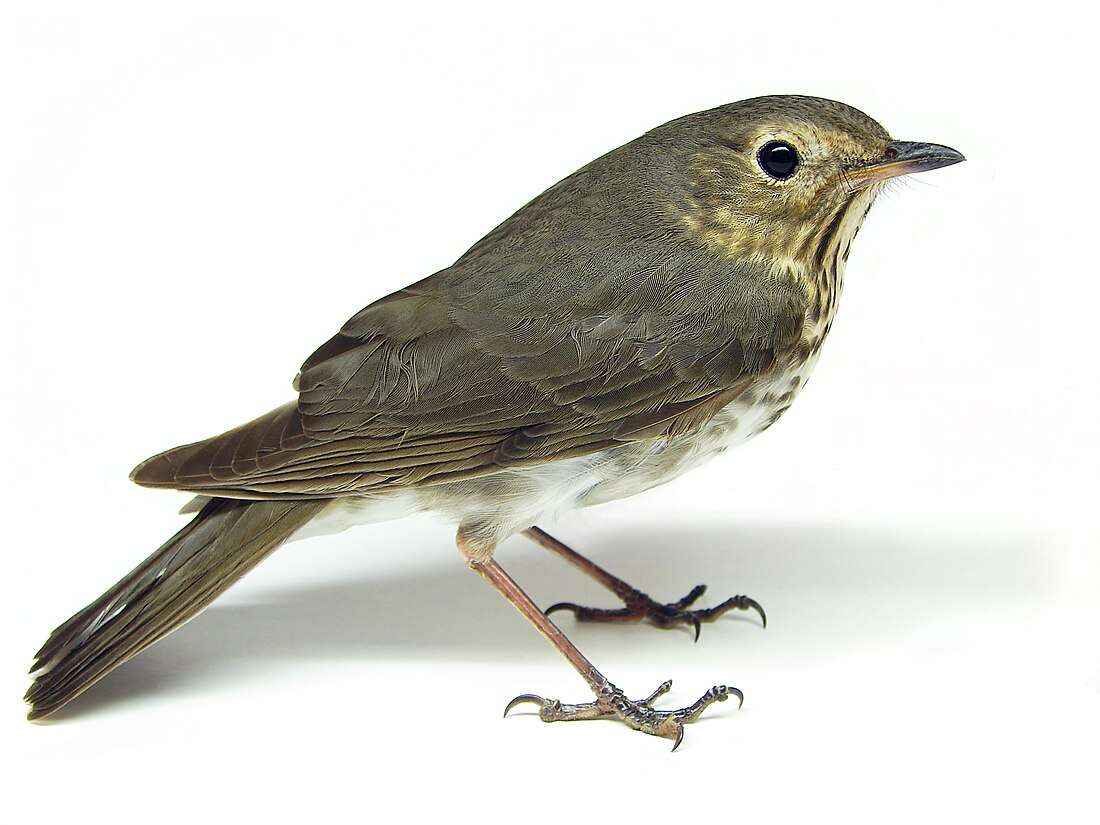Swainson's thrush
Species of bird From Wikipedia, the free encyclopedia
Swainson's thrush (Catharus ustulatus), also called olive-backed thrush and russet-backed thrush and salmonberry bird is a medium-sized thrush. It is a member of genus Catharus and is typical of it in terms of its subdued coloration and beautiful, ascending flute-like voice. Swainson's thrush was named after William Swainson, an English ornithologist.
| Swainson's thrush | |
|---|---|
 | |
| Scientific classification | |
| Domain: | Eukaryota |
| Kingdom: | Animalia |
| Phylum: | Chordata |
| Class: | Aves |
| Order: | Passeriformes |
| Family: | Turdidae |
| Genus: | Catharus |
| Species: | C. ustulatus |
| Binomial name | |
| Catharus ustulatus (Nuttall, 1840) | |
 | |
Breeding Migration Nonbreeding | |
| Synonyms | |
|
Hylocichla swainsonii | |
Etymology
The genus name Catharus comes from the Ancient Greek katharos, "pure or clean" and refers to the plumage of the orange-billed nightingale-thrush C. aurantiirostris. The specific ustulatus is Latin for "burnt", from urere, "to burn".[2]
Habitat
The breeding habitat of Swainson's thrush is coniferous woods with dense undergrowth across Canada, Alaska, and the northern United States; also, deciduous wooded areas on the Pacific coast of North America.
Range and distribution
These birds migrate to southern Mexico and as far south as Argentina. The coastal subspecies migrate down the Pacific coast of North America and winter from Mexico to Costa Rica, whereas the continental birds migrate eastwards within North America (a substantial detour) and then travel southwards via Florida to winter from Panama to Bolivia. Swainson's thrush is a very rare vagrant to western Europe. It has also occurred as a vagrant in northeast Asia.[3]
Threats
This section includes a list of references, related reading, or external links, but its sources remain unclear because it lacks inline citations. (December 2023) |
This species may be displaced by the hermit thrush where their ranges overlap. Possibly, the latter species adapts more readily to human encroachment upon its habitat. At least in the winter quarters, Swainson's thrush tends to keep away from areas of human construction and other activity.
Description
This species is 16–20 cm (6.3–7.9 in) in length. The wingspan averages at 30 cm (12 in) and the wing chord is 8.7–10.5 cm (3.4–4.1 in). The bill measures 1.5–1.9 cm (0.59–0.75 in) in length and the tarsus is 2.5 to 3.1 cm (0.98 to 1.22 in) long. This species' body mass can range from 23 to 45 g (0.81 to 1.59 oz).[4][5][6] This thrush has the white-dark-white underwing pattern characteristic of Catharus thrushes. Adults are brown on the upperparts. The underparts are white with brown on the flanks; the breast is lighter brown with darker spots. They have pink legs and a light brown eye ring. Birds in the east are more olive-brown on the upperparts; western birds are more reddish brown. This bird's song is a hurried series of flute-like tones spiralling upwards.
Diet
They forage on the forest floor, also in trees.[7] Swainson's thrushes mainly eat insects, fruits and berries.[8] They make a cup nest on a horizontal tree branch.
Its song is said by local tribes to make salmonberries ripen,[9] including the Saanich people who claim the bird says, "xwexwelexwelexwelexwesh!" meaning "ripen, ripen, ripen, ripen!" A similar belief appears among the Tlingit, Haida, Haisla, Oweekeno, Kwakwaka'wakw, Nuu-Chah-Nulth, Ditidaht, Sḵwx̱wú7mesh, and the Straits Salish people.[citation needed]
Subspecies
Summarize
Perspective
Four subspecies are recognised, Cathartus ustulatus alame, C. u. swainsoni, C. u. ustulatus and C. u. oedicus. Subspecies Cathartus ustulatus alame and C. u. swainsoni summer east of the British Columbian Coast Mountains, the Cascades and the Sierra Nevada, and C. u. ustulatus and C. u. oedicus summer west of these ranges. There is a small area of overlap in the Coast Mountains. Recent molecular systematics work[10] confirms that these two pairs of subspecies form two genetically distinct clades, referred to as the continental and coastal clades, which diverged during the Late Pleistocene era, probably about 10,000 years ago as the last ice age came to its end and habitats shifted across North America.
The genetic differences between the subspecies, and the circuitous migratory route of the continental birds, strongly suggest that these species underwent a rapid range expansion following the end of the last ice age, with populations originally summering in the south-east of North America expanding their ranges northwards and westwards as the ice retreated. Details of the molecular genetic analysis support the hypothesis of rapid expansion of both coastal and continental populations. The current migratory routes of the continental birds, especially the western populations, are not optimal in ecological terms, and presumably represent an inherited, historical route pattern that has not yet adapted to the birds' modern population locations.
These results notwithstanding, analysis of mtDNA cytochrome b and NADH dehydrogenase subunit 2 as well as nuclear β-fibrinogen intron 7 sequence data[11] shows that Swainson's thrush is the most ancient North American species of its genus; it is not closely related to other Catharus and the outward similarities with the other North American species are due to convergent evolution.
Gallery
- Swainson's thrush on South Padre Island, Texas
- On South Padre Island, Texas
- A Swainson's thrush in British Columbia
Footnotes
References
External links
Wikiwand - on
Seamless Wikipedia browsing. On steroids.




